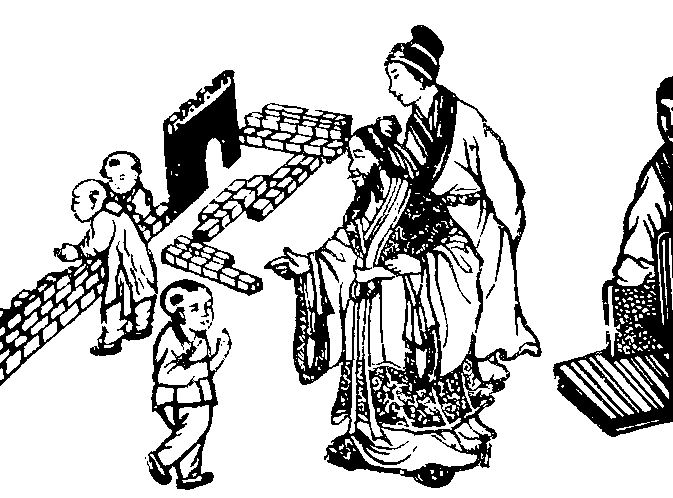
Content created: 2022-05-31
File last modified:
Go to English only version.

This page deals with Confucius’ encounter with a very self-confident seven-year old boy named Xiàng Tuó 项橐, who is blocking the road. The story is old, but in this version it comes from an XVIIIth-century children’s reader. Here is the background.
Children’s Readers. In late dynastic times an increasing variety of elementary reading books emerged in China, of varying pedagogical effectiveness, but ostensibly aimed at children and incorporating very general knowledge and repetitive injunctions to obey their superiors. In many cases they were made more appealing by the inclusion of illustrative woodcuts like the one shown below.
Easily the most famous one still in print today is the “Three Character Classic,” available on this web site with romaniztion in three dialects (link), but there were many others, often including in their titles the self-effacing expression “miscellaneous characters” or Zázì 杂字.

The “miscellaneous characters” text on this page comes from an anonymous work called the “Miscellaneous Characters from an Eastern Garden” (Dōngyuán Zázì 东园杂字) apparently published in Guǎngzhōu 广州 in 1743.
The story itself, however, is an old and famous one. It is off-handedly referred to in the “Strategies of the Warring States” (Zhànguó Cè 战国策) as revised in the early Hàn 汉 period (period 6). (Not surprisingly, knowledge of it is assumed in the “Three Character Classic” (chapter 8, line 112).
The 1743 version used here is therefore a retelling. It seems to be the version often included with other “pedagogical” material in traditional almanacs (tōngshū 通书) throughout the last dynasty and subsequently to the present.
No doubt it was the anecdote’s very ubiquity that led to its inclusion even in S. Wells Williams 1842 textbook, Easy Lessons in Chinese, where it is accompanied by Cantonese romanization, English word glosses, and an English translation.
The plot is simple. Briefly, Confucius goes out in his carriage, with some of his followers walking alongside. His way is blocked by a seven-year-old small urchin named Xiàng Tuó 项橐, who is ignoring his playmates and is using broken roof tiles to built a structure across the path. Confucius is forced to stop. He gets out and has a discussion with the child, who bests him in discoursing on Confucian orthodoxy, among other things. Confucius declares him a prodigy and proceeds on his way.
The traditional interpretation claims this as an edifying event. Confucius, China’s most venerable ancient sage, was never known to be especially fond of children, although it is reasonable to suspect that his own troubled youth may have left him sympathetic to kids out of step with their playmates, as here. (For a brief biography of Confucius, click here.) The famous man’s encounter with little Xiàng Tuó is said to demonstrate
(Which of these lessons is highlighted depends on the storyteller. The ode at the end of the present version, probably a later addition, stresses the second.)
The two-pronged traditional interpretation is no doubt the reason why this text has survived with other popular hortatory texts, and is even celebrated in some popular art like the following lintel decoration in a Taiwan temple.

Another possible interpretation is that the story is simple satire. Although I know of no Chinese commentator who sees it as such, the encounter lends itself to being read as a satire more persuasively than as adulation, rather like Zhuāngzǐ’s 庄子 famous account of Confucius’ humiliating meeting with Lǎozǐ 老子 (link).
When the story is seen as satire, the clearly prodigious child may be an asocial and sanctimonious brat, but Confucius is a self-important booby in need of having his chain pulled.
(Confucius’ initial attempt to befriend the kid smacks, for a modern reader, of a failed attempt at child abduction, but this would not have been part of a traditional satire.)
To argue for and against the two interpretations, I have inserted interpretative comments between sections of the narrative. Such ambiguity, in the face of a staid traditional interpretation of the child as a moral exemplar able to humble even Confucius, only increases the interest and charm of the text.
For the presentation here, I began with an on-line version of the Chinese text in traditional characters, made a few small corrections to agree with Williams’ seemingly more reliable version, repunctuated the text, and provided a new translation, guided in part both by Williams and by a rendering of much of it that occurs in Martin Palmer’s fascinating T’ung Shu: The Ancient Chinese Almanac. (Full references are at the end of the page.) The short sections have been numbered for easy reference in classes.
The Chinese text and my English translation may be reused for educational purposes with no further permission. The romanization and simplified characters were produced using BabelPad and have not been proofed except to correct the tone change in 好 when it is a verb (hào) as opposed to an adjective (hǎo).